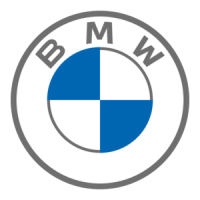Driving hints
125
Reference OverviewControlsCommunication NavigationEntertainmentMobility
and such equipment cannot be entirely ruled
out. There is moreover no guarantee that the
radiation generated when such devices are
transmitting will be dissipated out of the vehi-
cle's interior.<
Aquaplaning
When driving on wet or slushy surfaces,
reduce speed to prevent a wedge of water
from forming between the tyre and the road.
This situation, known as aquaplaning, means
that the tyre can actually lose contact com-
pletely with the road surface, with the result that
neither can the car be steered nor the brakes be
applied properly.<
Wading
Drive through water only to a max. depth
of 30 cm, approx. 12 in, and no faster than
walking pace, otherwise the engine, electrical
system and transmission may be damaged.<
Safe braking
Your BMW is equipped with ABS as standard.
Where a situation requires you to apply the
brakes hard, you are advised to do so. Since the
car remains steerable, you can avoid obstacles
by turning the steering wheel as smoothly as
possible.
The pulsating sensation at the brake pedal,
combined with the sound of the hydraulic sys-
tem operating, indicates that the ABS is inter-
vening.
Wet roads
In wet conditions or heavy rain, apply the brakes
briefly with slight pedal pressure every few kilo-
metres or miles. When doing so, make sure that
no other road user is endangered. The resulting
heat dries the brake discs and pads. The brak-
ing force will then be available immediately if
needed.
Downhill gradients
To avoid impairing the efficiency of the
brake system as a result of overheating,
drive down long or steep descents in the gear
that allows you to keep brake applications to a
minimum. Otherwise even slight continuous
pressure on the brake pedal could cause over-
heating, brake pad wear or even brake system
failure.<
The braking effect of the engine can be boosted
by shifting the gear down in the manual mode of
the automatic gearbox, if necessary as far as 1st
gear, see page 61. This prevents an excessive
stress on the brakes.
Never drive in neutral or with the engine
switched off; engine braking action will
not be present, or there will be no power assist-
ance to the brakes or steering.
Make sure that pedal functions are not impaired
by floor mats, carpets or other objects.<
Corrosion of brake discs
If the car is used only for short distances, is not
used for lengthy periods or is subjected to only
minor loads, the brake discs will be particularly
susceptible to corrosion and the brake pads will
collect dirt; this is because the necessary brake
pressure for a self-cleaning effect has not been
generated.
When the brakes are applied, corroded discs
tend to judder, and even lengthy brake applica-
tions usually fail to eliminate this effect entirely.
When vehicle is parked
Moisture condensate forms in the automatic air
conditioning and is discharged underneath the
car. Traces of water on the ground are therefore
normal.
Before entering a car wash
1. Fold in the outside mirrors, see page 48, as
they could otherwise be damaged due to
the car's width.
Observe the instructions on page 56, to
ensure that the car's wheels are free to roll
along.
2. Release the parking brake, particularly if
you have activated Automatic Hold, see
also page 57.
Online Edition for Part no. 01 41 0 013 197 - © 02/07 BMW AG

